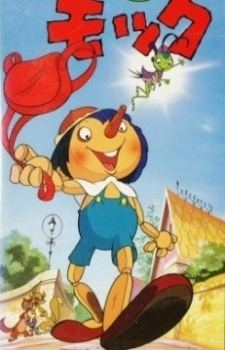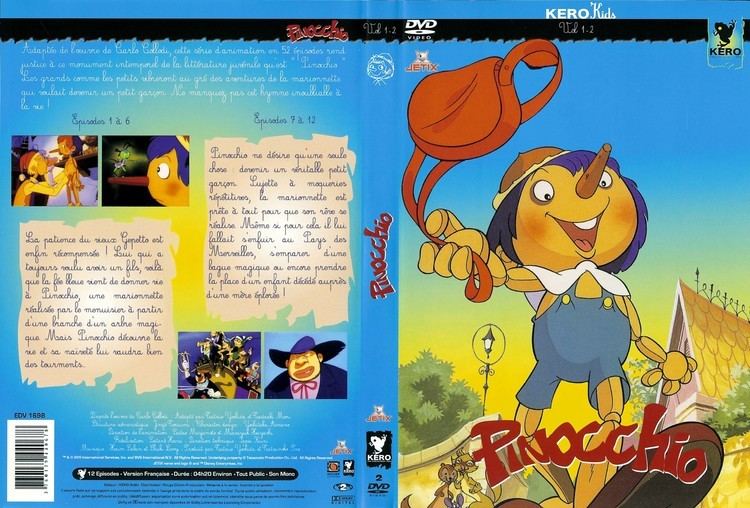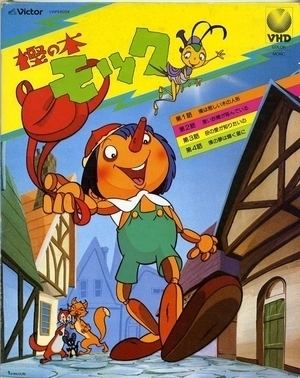6.8 /10 1 Votes
6.5/10 TV Studio Tatsunoko Production First episode date 1972 | 7.2/10 IMDb Directed by Seitaro Hara Original network Fuji Television Network Fuji Television Genres Fantasy, Drama | |||||||||||||||||||||||||||||||||
 | ||||||||||||||||||||||||||||||||||
Original run 4 January 1972 – 1 January 1973 Cast Hiroko Maruyama, Kaneta Kimotsuki, Minoru Yada, Masako Nozawa, Masako Ikeda Similar Adventures of the Little Mermaid, The Little Lulu Show, The Country Mouse an, The Kids from Room 402, Pinocchio | ||||||||||||||||||||||||||||||||||
Pinocchio: The Series, also known as Saban's The Adventures of Pinocchio and known in Japan as Mock of the Oak Tree (樫の木モック, Kashi no Ki Mokku) in Japan, is a 52 episode anime series by Tatsunoko Productions first aired on Fuji Television in 1972, which was edited by Saban in 1990. The story is based on the novel The Adventures of Pinocchio by Italian author Carlo Collodi.
Contents
- Plot overview
- English versions
- Staff
- Pinocchio The Series
- The Adventures of Pinocchio
- Music
- DVD availability
- References

Unlike the lighter, more cheerful tones of the Disney Version and Nippon Animation's version Piccolino no Bōken, this series has a distinctly darker, more sadistic theme, and portrays the main character, Pinocchio (Mock), as suffering from constant physical and psychological abuse and freak accidents.

Plot overview
This version of tells a story of an extremely gullible, naive and morally confused wooden doll/marionette brought to life by a mystical turquoise-haired fairy. Pinocchio (Mock) is characterized as having many character faults which he must learn to overcome in order to be worthy of being granted humanity. Some of these character faults include selfishness, sarcasm, insensitivity, indolence, obstinacy, over- trusting, self-pity, stupidity, disobedience, compulsive lying, arrogance, greed, cowardice, recklessness, cruelty, foolishness and an inability to learn from mistakes.

For example, during the fifth episode, 'What is a Heart', Pinocchio actually resorts to committing attempted murder to acquire a child's heart because he thinks it will help him become a real boy. Throughout the entire series Pinocchio (Mock), partly due to his own delinquency and repetitive disobedience, must undergo other costly ordeals of hardship and pain in which he is continuously tormented. In the tenth episode, 'When my nose gets longer', Pinocchio is forcefully adopted by a Nobleman and becomes a Prince, whereupon he becomes so corrupted with wealth and privileges that he becomes extremely cruel to his servants and charges about his adopted father's estates on horseback, randomly riding down any person who gets in his way, whilst laughing at the terror, indignity and danger inflicted upon others for his personal amusement. Pinocchio is of course severely punished by the blue fairy for these acts of utter selfishness who makes his nose turn into a small tree. Pinocchio is consequently disowned and cast out naked into the wilderness by his adopted father who can't stop laughing at him as he is dragged away crying out in vain for mercy. The episode ends with a forlorn Pinocchio weeping as he fumbles through the castle's surrounding undergrowth, naked and cold because his ex-adopted father has taken away his expensive attire. There are clearly illustrated scratches etched into the wood of his body from the surrounding vegetation. The subsequent episode sees Pinocchio transform into a small tree with a face and with roots fixed deep into the soil so that he can no longer move. He is eventually found by a wood cutter who chops him down and sells him as a novelty singing tree.
The cultural backdrop of these episodes seem to suggest an alpine region during the mid to late 19th century, only with an added mythical theme which includes creatures such as vampires, fairies, witches, dragons, demons and mermaids as well as talking animals and not to mention of course a living puppet. Such backdrops could include countries such as Switzerland, Austro-Hungary or even the Papal States or the Alps regions of Northern Italy.
English versions
The series was adapted into English in the 1990s by Saban Entertainment under the title Pinocchio: The Series (colloquial also known as Saban's (The) Adventures of Pinocchio). This version was shown in the United States on weekday mornings on HBO in 1992.
A separate English version was created by Jim Terry (Force Five). Titled The Adventures of Pinocchio, it consisted of several episodes edited together to create a 90-minute movie. This version, released on video in 1989, was dubbed by Harmony Gold, using different voice actors than the Saban version.
The on-screen title was given as 'Pinocchio The Series', to emphasize the fact that this was an independent production, unrelated to the Disney feature.
Staff
Pinocchio: The Series
The Adventures of Pinocchio
Music
This series uses several pieces of theme music for different adaptations. The original Japanese opening is "Kashi no Ki Mokku (樫の木モック)" which is sung by Kumiko Onoki. The original Japanese ending theme is "Boku wa kanashii ki-no ningyo (A Sad Wood Puppet Doll)" which is sung by Moon Drops. Whereas the intro carries an upbeat, "friendly" kids tune, the ending reflects the overall mood of the series.
The English adaptation has two songs, one for the mini movie made from the series, and the other for the actual 52 episode series that aired on HBO. These songs were "Whoa, Oh, Pinocchio" sung by Bullets for the movie, and "He's Pinocchio" produced by Saban. however in addition, when this series aired on HBO in 1992, Saban used a completely different instrumental theme song with no lyrics which differed from the "He's Pinocchio" song.
"He's Pinocchio" debuted on the Mexican Harmony Gold 1984 film release, this makes "He's Pinocchio" a Mexican Harmony Gold origin track. It was translated into English for the then upcoming 1990 Saban English series, to differ the English theme song for the series, from the Harmony Gold English movie version.
In the Saban version, Shuki Levy reused a lot of the music from the animated TV special The Adventures of Ronald McDonald: McTreasure Island produced by DIC Entertainment.
DVD availability
A selection of Pinocchio episodes are available in the UK at Amazon.co.UK under the title "The Magical World of Pinocchio". These are the American dubbed Jetix/Saban episodes, with the usual censorship (e.g. the cricket's death is not shown). A DVD of the Jim Terry feature-length version is also available on Amazon.com as "The Adventures of Pinocchio" from Warner Home Video.
